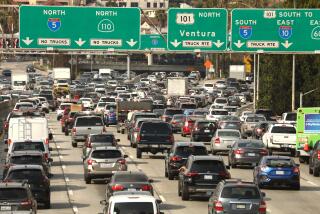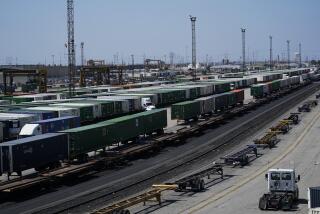Stricter Curbs on Tiny Airborne Particles Sought
- Share via
Seeking a crackdown on a dangerous air pollutant, the American Lung Assn. said Wednesday that a stricter limit on airborne particulates would produce nearly $11 billion a year in health-related savings and benefits in the United States.
Particulates are tiny pieces of carbon soot, acid, dirt and other substances that can lodge in lungs and obscure skies with a dark shroud of pollution. The Los Angeles region, particularly the Inland Empire, experiences some of the nation’s highest concentrations.
The lung association said the savings and benefits to Los Angeles County could reach nearly $2 billion a year.
Recent studies from Harvard Medical School and other researchers have shown a correlation between particulate pollution and premature deaths, especially among the elderly, as well as respiratory problems in children and asthmatics.
The lung association study estimates that toughening the particulate standard would annually prevent nearly 2,000 premature deaths, 13,000 cases of chronic bronchitis, 2,000 hospital admissions for respiratory problems, 36,000 emergency room visits and 14,000 acute bronchitis cases in children, adding up to $10.7 billion in health savings and benefits a year.
However, estimating the advantages of cleaning up air pollution has long been a difficult task, and the new report is based on numerous economic uncertainties.
Most notably, only a small portion of the report’s $10.7-billion figure was derived from direct health costs such as hospital care. Instead, $7 billion came from attaching a dollar value to the potential lost lives and ill health.
Each life was deemed worth about $3.5 million, an amount based on research that shows what an average person would be willing to spend to avoid an elevated risk of early death. Preventing each case of chronic bronchitis was assigned a worth of about $250,000.
In their report, the authors acknowledged that their estimates are based on “fairly extensive assumptions and approximations.”
If a tougher standard were imposed, Los Angeles County would be affected the most, with $1.96 billion in annual health benefits and savings, according to the study, which was conducted by a Colorado environmental consulting firm. San Bernardino ranked second with $839 million, followed by Chicago, New York City and Riverside.
The lung association advocated cutting the allowable daily average of particulates by two-thirds compared with the federal limit.
The U.S. Environmental Protection Agency--facing a court order imposed in a lung association lawsuit--has until 1997 to decide whether to strengthen the particulates standard. Some recent medical research has shown that the rule, set in 1986, is inadequately protecting the public.
The EPA is likely to impose a new limit focusing on the smallest particles--those less than 2.5 microns in diameter, a fraction of the width of a human hair--which have been linked to the most serious health problems.
Several dozen urban areas, especially the Los Angeles Basin, are struggling to comply with the current standard.
This year, the South Coast Air Quality Management District launched a project to find ways to reduce vehicle exhaust, dust from paved roads and other sources of particulates in the four-county basin. The cleanup is expected to cost millions, perhaps billions, of dollars per year.
More to Read
Sign up for Essential California
The most important California stories and recommendations in your inbox every morning.
You may occasionally receive promotional content from the Los Angeles Times.













